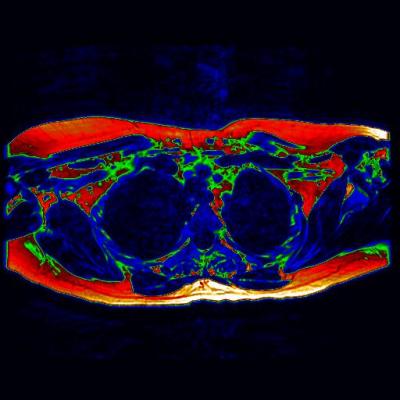Key milestone for brown fat research with a ground-breaking MRI scan

This is a digitally-enhanced axial MRI of the upper chest (as if viewed from the feet). Areas of potential brown fat are shown in green. Credit: University of Warwick, UHCW
Researchers from Warwick Medical School and University Hospitals Coventry and Warwickshire NHS Trust used a magnetic resonance imaging (MRI) based method to identify and confirm the presence of brown adipose tissue in a living adult.
Brown fat has become a hot topic for scientists due its ability to use energy and burn calories, helping to keep weight in check. Understanding the brown fat tissue and how it can be used to such ends is of growing interest in the search to help people suffering from obesity or at a high risk of developing diabetes.
Dr Thomas Barber, from the Department of Metabolic and Vascular Health at Warwick Medical School, explained, “This is an exciting area of study that requires further research and discovery. The potential is there for us to develop safe and effective ways of activating this brown fat to promote weight loss and increase energy expenditure – but we need more data to be able to get to that point.”
“This particular proof of concept is key, as it allows us to pursue MRI techniques in future assessments and gather this required information.”
The study, published in The Journal of Clinical Endocrinology and Metabolism, outlines the benefits of using MRI scans over the existing method of positron emission tomography (PET). Whilst PET does show brown fat activity, it is subject to a number of limitations including the challenge of signal variability from a changing environmental temperature.
Unlike the PET data which only displays activity, the MRI can show brown fat content whether active or not – providing a detailed insight into where it can be found in the adult body. This information could prove vital in the creation of future therapies that seek to activate deposits of brown fat.
Dr Barber added, “The MRI allows us to distinguish between the brown fat, and the more well-known white fat that people associate with weight gain, due to the different water to fat ratio of the two tissue types. We can use the scans to highlight what we term 'regions of interest' that can help us to build a picture of where the brown fat is located.”
With the proof of concept now completed, the next step is to further validate this technique across a larger group of adults.
The team includes Dr Barber, Professor Charles Hutchinson, Dr Terence Jones, Dr Narendra Reddy and Dr Sarah Wayte.
Dr Barber works at the Human Metabolism Research Unit at UHCW. The unit has benefitted from substantial investment through the Science City Research Alliance programme.
The Science City Research Alliance (SCRA) is a large scale, long-term research programme between the University of Birmingham and the University of Warwick.
Media Contact
More Information:
http://www.warwick.ac.ukAll latest news from the category: Medical Engineering
The development of medical equipment, products and technical procedures is characterized by high research and development costs in a variety of fields related to the study of human medicine.
innovations-report provides informative and stimulating reports and articles on topics ranging from imaging processes, cell and tissue techniques, optical techniques, implants, orthopedic aids, clinical and medical office equipment, dialysis systems and x-ray/radiation monitoring devices to endoscopy, ultrasound, surgical techniques, and dental materials.
Newest articles

Security vulnerability in browser interface
… allows computer access via graphics card. Researchers at Graz University of Technology were successful with three different side-channel attacks on graphics cards via the WebGPU browser interface. The attacks…

A closer look at mechanochemistry
Ferdi Schüth and his team at the Max Planck Institut für Kohlenforschung in Mülheim/Germany have been studying the phenomena of mechanochemistry for several years. But what actually happens at the…

Severe Vulnerabilities Discovered in Software to Protect Internet Routing
A research team from the National Research Center for Applied Cybersecurity ATHENE led by Prof. Dr. Haya Schulmann has uncovered 18 vulnerabilities in crucial software components of Resource Public Key…





















